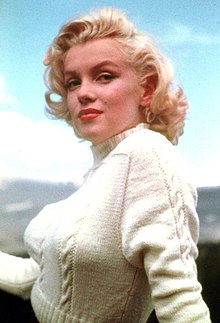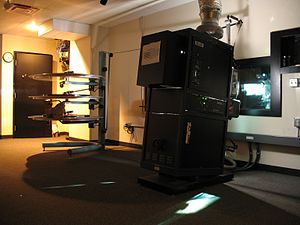Interesting social sciences/Culturology



Some pseudo‐scientists consider aesthetics as science about the beautiful and further these pseudo‐scientists go to the scholastic reasoning, from which there is no benefit. Instead, I will try to consider the development of such type of art, as show business on example of development of cinema. The development of cinema is result of relations for conflict and control. This my approach should serve as a model for the study of other kind of art.
Fashion
[edit | edit source]Basic provisions of the theory of fashion were formulated by George Simmel[1]. According to him, fashionable things are the identification marks indicating belonging to elite. The fashion is the aspiration of bottoms of society to imitate to elite. The fashion did not exist in primitive society because degree of inequality between people, extent of division of people into elite and mass was low in primitive society. The fashion did not change for centuries in caste society and estate society because mass had no right to imitate to elite under the law in caste society and estate society. Only representatives of elite – noblemen and priests – had the right to carry fashionable things in the Middle Ages in Western Europe. It was forbidden to representatives of the lowest estates under the law. Jewelry and furs were fashionable things in the Middle Ages in Western Europe. Merchants had money for acquisition of these things, but merchants had no right to carry fashionable things and merchants did not want to provoke of noblemen to robbery of himself. By the way, Russia which grew rich on trade in these fashionable goods was the chief supplier of furs to Western Europe.
The legal prohibition were cancelled on wearing any clothes, the speed of vertical mobility increased and the hereditary aristocracy disappeared during Modern history. Mass has begun to seek to imitate to elite and mass has begun to seek to wear fashionable things under capitalism with the purpose to resemble of representatives of elite at least externally. Therefore the elite is forced to invent constantly new fashion today that to be allocated from bottoms of society. Mass exhausted of elite in this sense so that the elite is forced even to repeat fashion on some things sometimes through a some period. Examples of repetitions of fashion is a thick sole - "platform shoe", Leather jacket, a wig. Examples of fashionable things and details of appearance from the recent past: trousers - "Bell-bottoms", very tight trousers ("macarons"), sunglasses, a beard, the shaven head "as the cool guy", tattoos, body piercing, a miniskirt, High-heeled shoe, Mercedes-Benz cars, the mobile phone, shorts. Representatives of youth subculture and young women follow for fashion especially fixedly.
“Future shock" in sphere of Russian cinema
[edit | edit source]The kinds of show business:
• circus,
• music,
• cinema,
• radio,
• phonograph record,
• television,
• video.
Phonograph record, as kind of show‐business, has disappeared already almost today as a result of the invention of the record of music on magnetic tape, the disks DVD and USB flash drive. In my opinion, it is necessary to consider the development of each kind of show business, including the development of cinema, as the result of the relations of social competition with other kinds of show business. Besides, the rapid technical progress in sphere of show business has left a huge mark on these relations, the development of technical progress has conducted to the consecutive invention of cinema, then television, and then video. These three kinds of show business exist in conditions of competition with each other for influence on the consumer today. Technical inventions in the field of the cinema appear with at breakneck speed, therefore employees of cinema feel shock from quick changes, which is described in the work of Alvin Toffler "Future shock".
Three stages in the development of Russian cinema:
[edit | edit source]




- Soviet power considered the cinema as tool of upbringing for Soviet citizens, that is, in fact, the cinema was a means of manipulation, means of control over public opinion. The purpose of cinema was the formation of false political stereotypes which were profitable for Soviet power. The purpose of cinema was upbringing of Soviet citizens with help of translation of the optimistic “fairy tales” about the achievements of Soviet society, therefore, the share of movies of foreign production in film distribution was insignificant. Cinema was part of the huge ideological machine on disinformation and deception of soviet citizens. Authorities limited the natural competition between workers of cinema for influence on the consumer. State censorship could forbid the show of popular film even and Soviet power could repress of creators of this popular film because of ideological reasons. Russian films were mediocre under Soviet power often, since censorship forbade the production of talented films, but, on the other hand, the Soviet Government allocated a lot of money for production of films and maintenance of unprofitable movie theater in small settlements even. it was necessary to show small documentary film before a good feature film; therefore the audience languished and audience were bored during broadcast of long speeches of ruler Leonid Brezhnev in the documentary film waiting of the Indian or American movie. New movies were showed in movie theaters only and new movies weren't showed on Central television under Soviet power.
- Censorship was cancelled in Russia in 1991. A broad stream of foreign, mainly American, films have rushed on the television screens of the country. The emergence of videocassette recorders in Russia had resulted to a blossoming of video salons where previously forbidden movies were showeded, since videocassette recorders was too expensive and usual man couldn’t buy this videocassette recorder and this man was forced to buy ticket to video salon. This competition in side of television and video salons had killed domestic Russian cinema almost, many movie theaters were closed in Russia, production of Russian films has stopped almost. The whole generation of people who never were at movie theater has grown.
- The revival of Russian cinema had begun in 2001 because of certain degradation of the quality of television programs and the beginning of the fight against video pirates. Advertizing revenues had turned out insufficient for acquisition by television of the rights for broadcast of new movies. Television management is forced today to fill the time of TV broadcast with annoying advertizing, old movies, cheap talk shows, culinary programs, quizzes, low-standard comic programs, silly film series (soap operas) and Star Academy. The number of television channels is becoming more and more, but the quality of the content of television programs are worse and worse. This decline in quality of content becomes inevitable, for example, because of reducing the terms of shootings for television’s films: director shoots one series in the television’s serial in video during one or two days, while director shoots feature film on cellulose acetate film during a few months. An impression is sometimes made that some series are designed for people with limited mental capacities. But, on the other hand, it has allowed to reduce the cost of movies on video in comparison with feature film on cellulose acetate film in many times. Everything returned to back today on a new step of technical development. Good new movies can be watched only at movie theater or with help of Internet in poor quality. Issue of disks DVD is delayed from Premier films in cinema theatres on one month approximately in Russia. This delaying exist that to protect cinema theatres from video‐pirates. Quality cinema demonstration of movies is higher quality of demonstration for television’s and video films always on such indicators as image sharpness and degree of illuminance of the screen. The sharpness of the image of the film on cellulose acetate remains unattainable standard for film on video disks. The power of xenon arc lamps in movie projector surpasses the power of incandescent light bulb in video‐projector in 10‐30 times, therefore the illuminance of screen during cinema show with help of movie projector also remains unattainable standard for video shows yet. Such high power of xenon arc lamps can be achieved with help of powerful rectifiers, ventilation and cooling of xenon arc lamps only. And nevertheless there was a transition in world cinema from expensive cellulose acetate film to cheap video and to disks in digital cinema contrary to decline in quality of cinema show today. Competition with side of television forced to enter in cinema such technical inventions as surround sound and video projector. Russian movie theatres began to be equipped with imported equipment today. For example, such technical devices have appeared, as platter system, which allows to save of projectionist from need to rewind cellulose acetate film before each session, it allow to put the entire film on one reel, to stick entire film in one ring and to show film on one movie projector without transitions from the one projector to other projector. Multiplexes (movie theaters, complexts with multiple screens within a single complex) exist today, where one projectionist by means of the computer can operate work of film projectors in several halls.
American movies tired to audience in Russia today because American movies are a product of conveyor, sample production and generation of alien culture therefore a need have arisen for new Russian movies. The Russian producers have learned much at the American producers and Russian producers are capable to make blockbuster which isn't worse than the western samples.
Сonclusion: it should be noted the pleasant fact that the Russian cinema hasn't died and Russian cinema could revive on a new step of technical development.
Personality types in the art and show business.
[edit | edit source]


This question in the paragraph is intended for help to those people who choose the profession of poet, artist, composer, projectionist or another profession in the sphere of show business. My tests to the personality type make it possible to define degree of suitability of the personality types on these professions. My tests can be used in the process of the selection of students into art schools and drama school.
Different personality types compete with each other in fight for roles in movies. The actor has to have high spirituality, high extraversion and high emotionality, only the psychologist possesses by high spirituality and high emotionality. This high spirituality and high emotionality is absent at technician and theorist completely, therefore technician and theorist are not suitable for the role of actor completely, but technician is suitable for the role of the technical worker in the sphere of art, for example for the role of camera operator or projectionist. Speaker possesses by low spirituality. Speaker possesses by highest degree of extraversion, which helps him to be outstanding orator and not to have fear before public on the theatrical scene, where speaker feels itself as fish in the water. Theorist possesses highest degree of introversion therefore theorist feels panicky fear before the public on the theatrical scene frequently. Psychologist and technician can possess by extraversion in average degree. This combination of high spirituality and a average degree of extraversion gives to game on the scene large depth at psychologist. Psychologist possesses by highest degree of emotionalism in comparison with other personality types. Psychologist lives by feelings and intuition as animal, but not by reason often. The high spirituality of psychologists is manifested in the ability to create lyric works. Of course, belonging to personality type of the psychologist doesn't guarantee to the person existence of huge talent yet, but guarantees high degree of suitability for a role of the worker of art. Only the lyrics and high spirituality of the psychologist allow him to cause in reply high degree of empathy of the audience. Speakers are deprived of these abilities completely. Speaker is the trickster, who attempts to imitate high spirituality frequently, speaker sings as brass instrument without any feelings and emotions, but this, if one may say so, "creativity" doesn't cause empathy of the audience completely. Speaker can have perfectly trained voice even, speaker can have many money on self-advertisement, speaker can have many friends in the sphere of show business, speaker can have many impudence and enterprise, but speaker does not know how to fulfill songs and to compose verses 'with the soul'. Therefore speaker is forced to search of love of the authorities, for this purpose speaker is capable to sing optimistic, civil and even the Party‐Communist songs under the Soviet regime as Vladimir Mayakovsky, Joseph Kobzon and Lev Leshchenko. There are different stock character in the cinema, for example, stock character of absent-minded professor, Hooker with a heart of gold, Hopeless Romantic, Tortured artist or Lovers are intended for the psychologist, and stock character of compere, Criminal, Outlaw, Jock (athlete), Supersoldier, Swashbuckler, Superhero, Town drunk, White hunter, Tomboy or clown are suitable for a speaker. For example, the most successful roles of speaker Vladimir Vysotskiy were roles of detective, mountain climber or criminal. Vladimir Vysotsky has cried out to the people "truth" in own songs contrary to censorship persecutions. Psychologists as the clown or the courageous hero have a little pathetic appearance. Speakers as the hero lover aren't able to represent depth of love experiences thinly.
Examples of psychologists in the sphere of the art are singers – Michael Jackson, Demis Roussos, Joe Dassin, Alla Pugacheva, Lyubov Uspenskaya, Philipp Kirkorov, Alexander Malinin, Pyotr Leshchenko, Alexander Vertinsky, Larisa Dolina, Alexander Gradsky, Lolita Milyavskaya, Anzhelika Varum, Verka Serduchka (Andrey Danylko). Examples of psychologists in the sphere of the art are actors ‐ Marilyn Monroe, Leonardo DiCaprio, Dmitriy Pevtsov, Renata Litvinova, Konstantin Khabensky, Elena Solovey, Angelina Jolie, John Travolta, Georgy Vitsin, Aleksey Batalov. Examples of psychologists in the sphere of the art are poets and writers ‐ Sergei Yesenin, Alexander Pushkin, Mikhail Lermontov, Leo Tolstoy, Fyodor Dostoyevsky, Maxim Gorky, Anton Chekhov. Examples of psychologists in the sphere of the art are film director ‐ Andrei Tarkovsky, Leonid Gaidai, Sergei Bondarchuk. Examples of psychologists in the sphere of the art are clowns ‐ Aleksandr Tsekalo, Savely Kramarov.
Examples of speakers in the sphere of the art are singers ‐ Nikolay Baskov, Vladimir Vysotsky, Laima Vaikule, Oleg Gazmanov, Garik Sukachov, Sergey Shnurov. Examples of speakers in the sphere of the art are actors - Gérard Depardieu, Sylvester Stallone, Bruce Willis, Steven Seagal, Arnold Schwarzenegger, Mikhail Boyarsky, Alexandr Abdulov. Examples of speakers in the sphere of the art are film directors ‐ Stanislav Govorukhin, Eldar Ryazanov, Nikita Mikhalkov, Quentin Tarantino. Examples of speakers in the sphere of the art are clowns ‐ Vladimir Vinokur, Viktor Sukhorukov. It is rumored, that Vladimir Mayakovskiy wrote his verses short flight of stairs and Vladimir Mayakovskiy went on editions with a cane that to beat out more money for own verses. Speakers as film director are able to lead troupe and Speakers prefer to shoot blockbuster or comedies. Psychologists prefer to shoot love stories, eroticism, fantasy, horror film or author's cinema, difficult for understanding of most of the audience. For example, Andrey Tarkovsky's author's films won prizes at the international film festivals, but this films did not bring profit to film distributor.
Bohemian style is style of behavior for man in community of actors. Bohemian style means wide circulation of debauchery, drugs and homosexuality often, because of a big share of psychologists among community of actors. Man‐psychologists adhere to nontraditional sexual orientation frequently, for example Boris Moiseev, or they prefer to come out into the woman's dress as Andrey Danilko and Conchita Wurst.
As the conclusion, it is necessary to note that this personality type as psychologist is most suitable to the role of actor, and speaker is the imitator of spirituality and trickster in the art frequently. In general, speakers test themselves in all areas of the life for society, but, in spite of their ambitions and high enterprise, speakers have only partial suitability often.
Citations and references.
[edit | edit source]- ↑ Georg Simmel. Fashion. The American journal of sociology. Vol, 62 No. 6 May 1957. http://sites.middlebury.edu/individualandthesociety/files/2010/09/Simmel.fashion.pdf